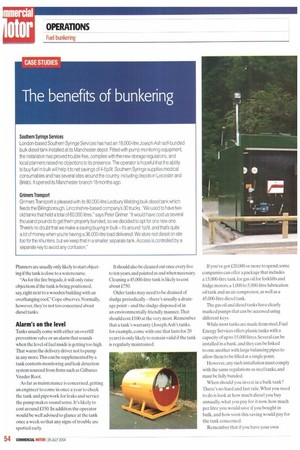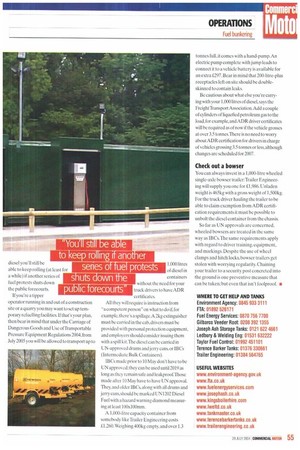DIESEL RULES OK
Page 52

Page 53

Page 54

Page 55

If you've noticed an error in this article please click here to report it so we can fix it.
Bunkering can cut your fuel bill.
But Steve Banner warns that you
can't afford to overlook the latest fuel storage regulations.
Cash-strapped small operators may be tempted to ignore tough new rules on the bulk storage of diesel that come fully into force in little more than a year's time.That's the concern of Tim Cope, a director at Joseph Ash Storage Tanks.
"My personal view is that a lot of them will leave compliance until the very last moment," he remarks. "Alternatively they'll bury their heads in the sand, and won't take any action at all."
The new rules are the Control of Pollution (Oil Storage) (England) Regulations 2001. They apply to firms that keep diesel and substances such as gas oil and lubricating oil in containers bigger than 200 litres above ground.
The most important requirement is that all such containers must be surrounded by a buffer zone to contain leaks. Known as a bund, it must be big enough to hold 110% of the tank's capacity and all vent pipes, filters and valves must be positioned within the bunded area too.
The new regs also deal with measures to prevent the tank from being overfilled.The hose used to fill trucks must be equipped with a valve that shuts off automatically when it's not in use and should be either equipped with a lockable security valve or locked inside a cabinet, All new tanks have had to comply since 1 March 2002.
Existing tanks deemed to be "at significant risk"within 50m of a well or bore hole, or within 10m of a river,stream, or coastal water have had to comply since 1 September 2003. However, all tanks, no matter what their age or where they're positioned, will have to comply from 1 September 2005. Similar regulations are under consideration in Wales, Scotland, and Northern Ireland.
Ostrich-like behaviour won't be tolerated by the Environment Agency, the body responsible for enforcing the regulations in England, or. more importantly, by the courts Substantial fines and even custodial sentences can be imposed on conviction.
However, from 1 September onwards the agency is organising 26 free half-day seminars at various locations nationwide to explain the new rules and how to comply with them. It can also provide guidance notes on bulk fuel installations.
Keep it legal
So what does an operator contemplating a rusty old tank sitting on railway sleepers and breeze blocks need to do to stay within the law? Cost invariably means that replacing it with an underground tank is out of the question.The best option is to install an overground prefabricated tank with a built-in bund and a removable roof. While surrounding a tank with a brick bund open to the elements is always an option, it will gradually fill up with rainwater, leaves and litter, all of which will eventually have to be removed.
Equipping the bund with a drainage valve, so that rainwater can flow out and into the nearest drain, is strictly forbidden in case it has become contaminated with diesel.
Some tank suppliers are concerned about the ability of concrete or brick blinds to retain diesel spillages. "In most cases they're just not up to the job," says Kevin Powell, sales director at Ledbury Welding and Engineering.
Tanks with a capacity of up to 150,000 litres are available, but most small-to medium sized operators typically invest in a self-bunded tank that will hold 45,000 litres. Complete with a new pump. it will cost about f15,000more if you're looking to fit additional pumps and a monitoring systemand is delivered as a complete package weighing about seven tonnes. If the operator changes premises it shouldn't be too difficult to transport it to the new site.
"So far as ground works are concerned, all that's needed is either a concrete pad or decent hard standing," says Cope. "But remember that it will weigh getting on for 50 tonnes when full."
A concrete apron in front of the pumps is advisable too, says Powell. It's also worth thinking about protecting the tank and pumps with a crash barrier. Making sure it's well lit at night will also help stop it being struck by a passing truck.
Operators should notify their insurers and inform the local planning department and the fire brigade prior to installation. "Speak to your landlord too if the yard is leased," says Gerald King, managing director ofTaylor Fuel Control. Planners are usually only likely to start objecting if the tank is close to a watercourse.
"As for the fire brigade,it will only raise objections if the tank is being positioned, say, right next to a wooden building with an overhanging roof," Cope observes. Normally, however, they're not too concerned about diesel tanks.
Alarm's on the level
Tanks usually come with either an overfill prevention valve or an alarm that sounds when the level of fuel inside is getting too high. That warns the delivery driver not to pump in any more.This can be supplemented by a tank contents monitoring and leak detection system sourced from firms such as Gilbarco Veeder Root.
As far as maintenance is concerned, getting an engineer to come in once a year to check the tank and pipework for leaks and service the pump makes sound sense. It's likely to cost around £150. In addition the operator would be well advised to glance at the tank once a week so that any signs of trouble are spotted early. It should also be cleaned out once every five to ten years, and painted as and when necessary. Cleaning a 45,000-litre tank is likely to cost about £750.
Older tanks may need to be drained of sludge periodically —there's usually a drainage point — and the sludge disposed of in an environmentally friendly manner.That should cost £100 at the very most. Remember that a tank's warranty (Joseph Ash's tanks, for example, come with one that lasts for 20 years) is only likely to remain valid if the tank is regularly maintained. If you've got £20.000 or more to spend, some companies can offer a package that includes a 15,000-litre tank for gas oil for forklifts and fridge motors, a 1,000 to 5,000-litre lubrication oil tank and an air compressor, as well as a 45.000-litre diesel tank.
The gas oil and diesel tanks have clearly marked pumps that can be accessed using different keys.
While most tanks are made from steel, Fuel Energy Services offers plastic tanks with a capacity of up to 15,000 litres. Several can be installed in a bank, and they can be linked to one another with large balancing pipes to allow them to be filled at a single point.
However, any such installation must comply with the same regulations as steel tanks, and must be fully bunded.
When should you invest in a bulk tank? There's no hard and fast rule. What you need to do is look at how much diesel you buy annually, what you pay for it now, how much per litre you would save if you bought in bulk, and how soon this saving would pay for the tank concerned.
Remember that if you have your own diesel you'll still be able to keep rolling (at least for a while) if another series of fuel protests shuts down the public forecourts.
If you're a tipper operator running in and out of a construction site or a quarry you may want to set up temporary refuelling facilities. If that's your plan, then bear in mind that under the Carriage of Dangerous Goods and Use of Transportable Pressure Equipment Regulations 2004. from July 2005 you will be allowed to transport up to 1,000 litres of diesel in containers without the need for your truck drivers to have ADR certificates.
All they will require is instruction from "a competent person" on what to do if, for example, there's a spillage.A 2kg extinguisher must be carried in the cab, drivers must be provided with personal protection equipment, and employers should consider issuing them with a spill kit.The diesel can be carried in UN-approved drums and jerry cans, or IBCs (Intermediate Bulk Containers).
IBCs made prior to 10 May don't have to be UN approved; they can be used until 2019 as long as they remain safe and leakproof.Those made after 10 May have to have UN approval. They, and older 1BCs. along with all drums and jerry cans, should be marked UN1202 Diesel Fuel with a hazard warning diamond measuring at least 100x100mm.
A 1,000-litre capacity container from somebody like Trailer Engineering costs 11,260. Weighing 400kg empty. and over 1.3 tonnes full, it comes with a hand-pump. An electric pump complete with jump leads to connect it to a vehicle battery is available for an extra £297. Bear in mind that 200-litre-plus receptacles left on site should be doubleskinned to contain leaks.
Be cautious about what else you're carrying with your 1,000 litres of diesel,says the Freight Transport Association.Add a couple of cylinders of liquefied petroleum gas to the load, for example,andADR driver certificates will be required as of now if the vehicle grosses at over 3.5 tonnes.There is no need to worry about ADR certification for drivers in charge of vehicles grossing 3.5 tonnes or less, although changes are scheduled for 2007.
Check out a bowser You can always invest in a 1,0(X)-litre wheeled single-axle bowser trailer:Trailer Engineering will supply you one for £1,986. Unladen weight is 465kg with a gross weight of 1,500kg. For the truck driver hauling the trailer to be able to claim exemption from ADR certification requirements it must be possible to unbolt the diesel container from the chassis.
So far as UN approvals arc concerned, wheeled bowsers are treated in the same way as IBCs.The same requirements apply with regard to driver training, equipment, and markings. Despite the use of wheel clamps and hitch locks, bowser trailers get stolen with worrying regularity. Chaining your trailer to a security post concreted into the ground is one preventive measure that can be taken: but even that isn't foolproof. •


















































































































































































